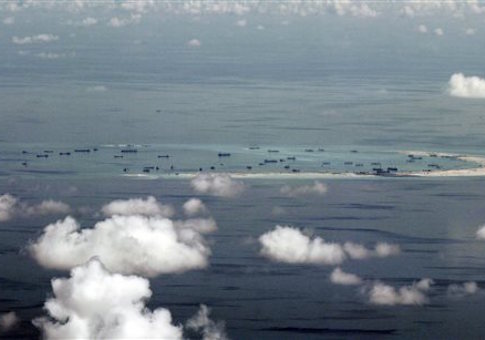In a major policy shift, the Pentagon declared Wednesday the United States will directly defend U.S. national security interests in the South China Sea against China’s expansive and illegal maritime claims.
David Shear, assistant defense secretary for Asia and Pacific affairs, told a Senate hearing that China’s claims over almost all of the Southeast Asian sea are destabilizing and risk a regional conflict with states such as Vietnam, Philippines, and Malaysia.
"DoD is taking action to protect U.S. national interests in the South China Sea: peaceful resolution of disputes, freedom of navigation and overflight and other internationally lawful uses of the sea related to these freedoms, unimpeded lawful commerce, respect for international law, and the maintenance of peace and stability," Shear told the Senate Foreign Relations Committee.
A defense official, meanwhile, said Defense Secretary Ash Carter has requested options for sending additional U.S. aircraft and ships to the South China Sea and deploying them within 12 miles of disputed Spratlys islands reefs where China has been building potential military facilities.
"We are considering how to demonstrate freedom of navigation in an area that is critical to world trade," one official told Reuters.
Recent Chinese activities to claim control over the sea have raised alarms, Shear said. "We see a pattern of behavior that raises concerns that China is trying to assert de facto control over disputed territories, and strengthen its military presence in the South China Sea," Shear said in prepared testimony.
China’s land reclamation—some 2,000 acres of underwater reefs and shoals have been expanded since last year—is raising new fears of Chinese aggression.
"Militarily speaking, China’s land reclamation could enable it, if it chose, to improve its defensive and offensive capabilities, including: through the deployment of long-range radars and [intelligence, surveillance and reconnaissance] aircraft to reclaimed features; ability to berth deeper draft ships at its outposts and thus to expand its law enforcement and naval presence further south into the South China Sea," he said.
"Airstrips will provide China with a divert airfield for carrier-based aircraft, enabling China to conduct more sustained air operations," Shear added. "Higher end military upgrades, such as permanent basing of combat aviation regiments or placement of surface-to-air, anti-ship, and ballistic missile systems on reclaimed features, would rapidly militarize these disputed features in the South China Sea."
To bolster forces, the Pentagon is upgrading alliances with Japan and Australia and increasing warship and other military deployments to Asia and the South China Sea, Shear said.
The presence includes ship visits, reconnaissance aircraft flights, and military exercises with Philippines, Malaysia, and Vietnam. Additional military assistance and intelligence of Chinese activities in the sea also is being provided.
"This presence not only reinforces our regional diplomacy, it also deters provocative conduct and reduces the risk of miscalculation in the area," he said.
The declaration is the most concrete statement to challenge China’s broad maritime claims since 2010, when then-Secretary of State Hillary Clinton declared the region a U.S. national security interest.
China protested that comment and warned Wednesday against the United States taking a greater security role in the region.
China's Foreign Ministry said Beijing is "extremely concerned" about new U.S. plans to add forces to the region.
"Freedom of navigation certainly does not mean that foreign military ships and aircraft can enter another country's territorial waters or airspace at will," ministry spokeswoman Hua Chunying told reporters in Beijing.
Daniel Russel, assistant secretary of state for East Asian and Pacific Affairs, testified that China was misrepresenting its objectives in reclaiming some 2,000 acres of South China Sea islands since last year.
"No matter how much sand you pile on a reef in the South China Sea, you can’t manufacture sovereignty," Russel said.
In particular, Beijing is building what appear to be military facilities, including an airstrip, as part of illegal claims to own some 90 percent of the sea through a self-declared "Nine-Dash Line" around the strategic waterway.
"China is constructing facilities on these expanded outposts, including at least one air strip on Fiery Cross reef that looks to be the longest air strip in the Spratlys and capable of accommodating military aircraft," Russel said.
China’s justifications for the construction have included statements that the bases are for disaster relief, environmental protection, and scientific research.
"More recently, Beijing indicated that it might utilize the islands for military purposes," Russel said. "The Chinese Foreign Ministry stated that the outposts would allow China to ‘better safeguard national territorial sovereignty and maritime rights and interests’ and meet requirements for ‘military defense.’"
The comments have destabilized the region by prompting fears of Chinese aggression by states in the region, when combined with China’s large-scale military buildup of ships, aircraft, and missiles, he said.
The officials’ testimony followed publication of the Pentagon’s annual report on the Chinese military that adopted a blunt tone in describing what it called low-level coercion by China in the South China Sea.
"China has used low-intensity coercion to advance its maritime jurisdiction over disputed areas of the East China Sea and South China Sea," the report said.
The measures have included punitive trade policies, trade tariffs, tourism restrictions, and limits on direct foreign investment.
Chinese coast guard ships, PLA warships, and commercial fishing fleets have each played a role in pursuing Chinese policy in the disputed seas.
"The PLA Navy primarily plays a deterrence role in China’s use of low intensity coercion and refrains from becoming directly involved in territorial and maritime disputes to avoid escalation," the report adding that "although the PLA Navy remains at a distance, its deployed surface combatants are ready to respond to a deteriorating security environment."
